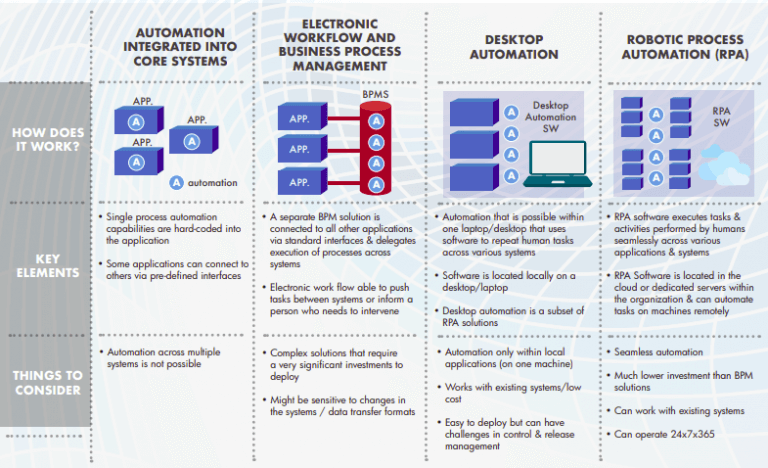
5 RPA Technology Implementation Benefits for Organizations
RPA is an exciting technology and every organization is trying to get their hands on it. The robotic process automation market is growing exponentially and the spending on RPA software is expected to reach $1 billion by 2020 with the annual growth rate of 41%, as reported by Gartner.
But why are companies switching to robots and automation at such a rapid pace?
Robotic process automation technology enables the organization to automate routines tasks like data entry and manual work. This allows the employees to concentrate on creative tasks and decision-making which maximizes their productivity. It presents a great opportunity to multiply the pace of operation and achieve greater efficiencies by cutting costs of manual labor that was indulged in mundane tasks. An example of RPA implementation is in repetitive processing of data which earlier involved the same keystrokes and can now be replaced with robots to automatically fill that data.
Types of RPA Process

Implementing the Robotic Process Automation Software
Installing robots and automating work allows the business to deliver seamless value without any exceptions. These bots come in two categories: Attended and Unattended. Attended bots require attention from human personnel and need employee interaction to simplify the workflow. They are triggered by employees to perform specific tasks in a quick manner. On the other hand, unattended bots do not require special assistance from employees. They are designed to automate work by operating in the background and don’t require much interaction with the employees.
While most companies have a fair idea of robotic process automation technology, they struggle to implement it properly. They know that bots are capable of diverse tasks ranging from copying & pasting of data to transferring customer service complaints but they cannot determine how to work around it. A complete blueprint that outlines the steps to implement RPA can come in handy for achieving efficiency in their workflow and increase organizational productivity.
- Executives Approval
- First & foremost, getting approval from the upper management is imperative to implementing RPA. Since it’s a new technology, executives might hesitate but generally, they are eager to invest in innovation that can augment their productivity and maximize efficiency.
- In fact, a PwC survey reported that 98% of respondents, that were business leaders, agree that automation is important or extremely important. To get approval, the executives need to be convinced of the cost-benefit approval for implementing RPA which can be in terms of reduction in cost and lower time consumption for mundane tasks.
- A proper analysis of ROI on RPA will give them a fair idea of what the technology is capable of achieving.
- Financial Implementation
- One of the simplest ways to implement RPA solutions is to start with the financial department. The organization can leverage RPA capabilities for analytics, data entry and manual reporting of accounts.
- RPA enables auditors to retrieve important data from the client file and simplify the auditing process. They can also compare the outcomes of the previous accounting period with the current one and create alerts when the specified budget exceeds the expectations.
- Cutting Down Costs
- RPA organizes the workflow by providing space to employees for productive tasks. The major benefit of replacing human personnel with bots for repetitive tasks occurs in the forms of reduced costs. According to Hackett Group, RPA can mitigate transactional costs by 50-75 percent.
- Even in big organizations, payables & receivables, spending, HR tasks are being handled by bots that once required expensive personnel. Not that they are eliminating their jobs, but they are working in alignment with this personnel to reduce cost as much as possible.
- Supporting Product Development
- Product development is one of the core activities of any organization. It is the product that enables the company to address itself as capable.
- With RPA services, software teams can align their knowledge with the efficiencies of AI and innovative technology to add enhanced features and benefits in the products.
- Repetitive tasks in development can be subordinated to robots which allow developers to focus more on their area of expertise.
- RPA Ready Teams
- RPA is a boon for those teams that are ready to venture into newer technologies and explore its capabilities. Intelligent automation supports the teams by acting as a tool to amplify their productivity.
- Teams can receive RPA certifications which give learners a comprehensive overview of RPA concepts and teach them how to use the technology to their advantage. Employees who are ready to adopt RPA can also explore opportunities in the domain of AI.
- They can upgrade their skills and gain a better understanding of machine learning, deep learning and intelligent neural network based research work.
From banking to life sciences, RPA is taking every industry by storm. RPA is transforming the way the world works in the 21st century by automating tasks that shouldn’t require human personnel. It makes lives easier and simpler for those that work around them.
RPA integrated with data science and Artificial Intelligence will enhance the organization’s capabilities and bring a new revolution of technology in the world.




